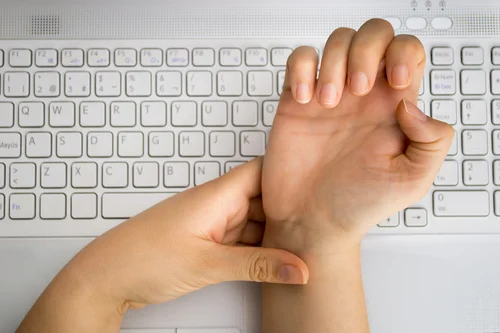Do you get hand cramps or forearm cramps in your dominant hand? Do you wish you were a little more ambidextrous? You are not alone. A couple of weeks ago in class, someone asked if we could look at the differences between our dominant and non-dominant hands, so last week, we did a lesson that explored how to decrease constantly held tension in our dominant hand and arm and how to increase coordination in our non-dominant hand. It was a huge hit, and is easy to do in most settings, so I'll share part of it here, along with part of a related lesson.
Hand cramps. Yuck.
Mini-lesson #1: This lesson works best if you can rest your elbow on an armrest or table if sitting, or the floor if you can lie down. Start with your dominant hand. Stand your hand and forearm over your elbow and notice what shape you hold your hand in as it rests there. Begin to slowly curl your fingers and soften your palm so you can gently drop your hand from the wrist. Slowly move a few times between having your hand upright and having your hand dropped, keeping your fingers and palm soft.
Once you've gotten an idea of how to let your hand hang in that dropped position, explore what it's like to allow one finger to move at a time. Begin with your thumb - hold your other fingers still and only move your thumb around a tiny bit. When you're ready, switch to moving only your pointer, then only middle, then only fourth, then only pinky. If you find your other fingers trying to help, slow down and shrink the movement of the finger you're intentionally moving.
Switch hands. You will probably find that the first half is easier with your non-dominant hand (because it holds less tension to begins with), but that the second half is much harder. Be patient with yourself as you figure out the necessary coordination for how to move non-dominant fingers individually.
Mini-lesson #2: Rest your hands palm-down on your thighs. Starting with your dominant hand, gently press each fingertip independently, one after another, then switch hands. For some extra fun, you can find toe mobility by pressing the same toe to the floor at the same time (ie. right thumb and right big toe press at the same time). Again, be patient.
If you find this really intriguing, or totally confusing, and want to learn more about it, let's talk!

